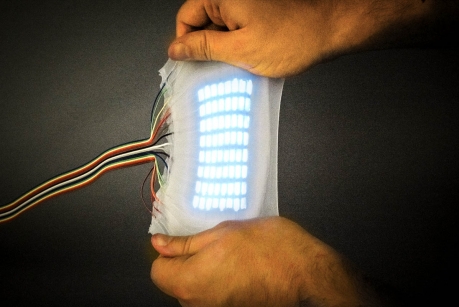Engineers from Cornell University are making headway in the soft robotics field, bringing us closer to real-life health care robots that light-up to indicate mood and displays that change instantly to cater to user’s needs.
Assistant Professor of mechanical and aerospace engineering, Robert Shepherd, along with a team of graduate students has developed a stretchable electroluminescent skin that is capable of stretching to nearly six times its original size while still emitting light.

The material allows robots to change their shape, while still maintaining color. What makes this possible is a hyper-elastic light-emitting capacitor (HLEC), which can endure more than twice the stress of other tested stretchable displays and consists of layers of transparent hydrogel electrodes that enclose a dielectric (insulating) elastomer sheet. The elastomer is what lights up and stores the electricity —even when it’s stretched, rolled, and manipulated in any way.
“We can take these pixels that change color and put them on these robots, and now we have the ability to change their color,” said Shepherd, in the Cornell Chronicle. “Why is that important? For one thing, when robots become more and more a part of our lives, the ability for them to have emotional connection with us will be important. So to be able to change their color in response to mood or the tone of the room we believe is going to be important for human-robot interactions.”
Not only can it maintain its color, but it has unprecedented stretching properties, so it can stay lit while stretching more than 480% its original size.
The team’s prototype robot consisted of three six-layer HLEC panels. The top four layers comprised the light-up skin and the bottom two contained the pneumatic actuators, which were inflated and deflated to make it look like the robot was crawling.
According to the researchers, future applications for the skin include health care, transportation, and electronic communication, and wearable devices.
Watch the stretch robot demonstration below.

Comments are closed, but trackbacks and pingbacks are open.